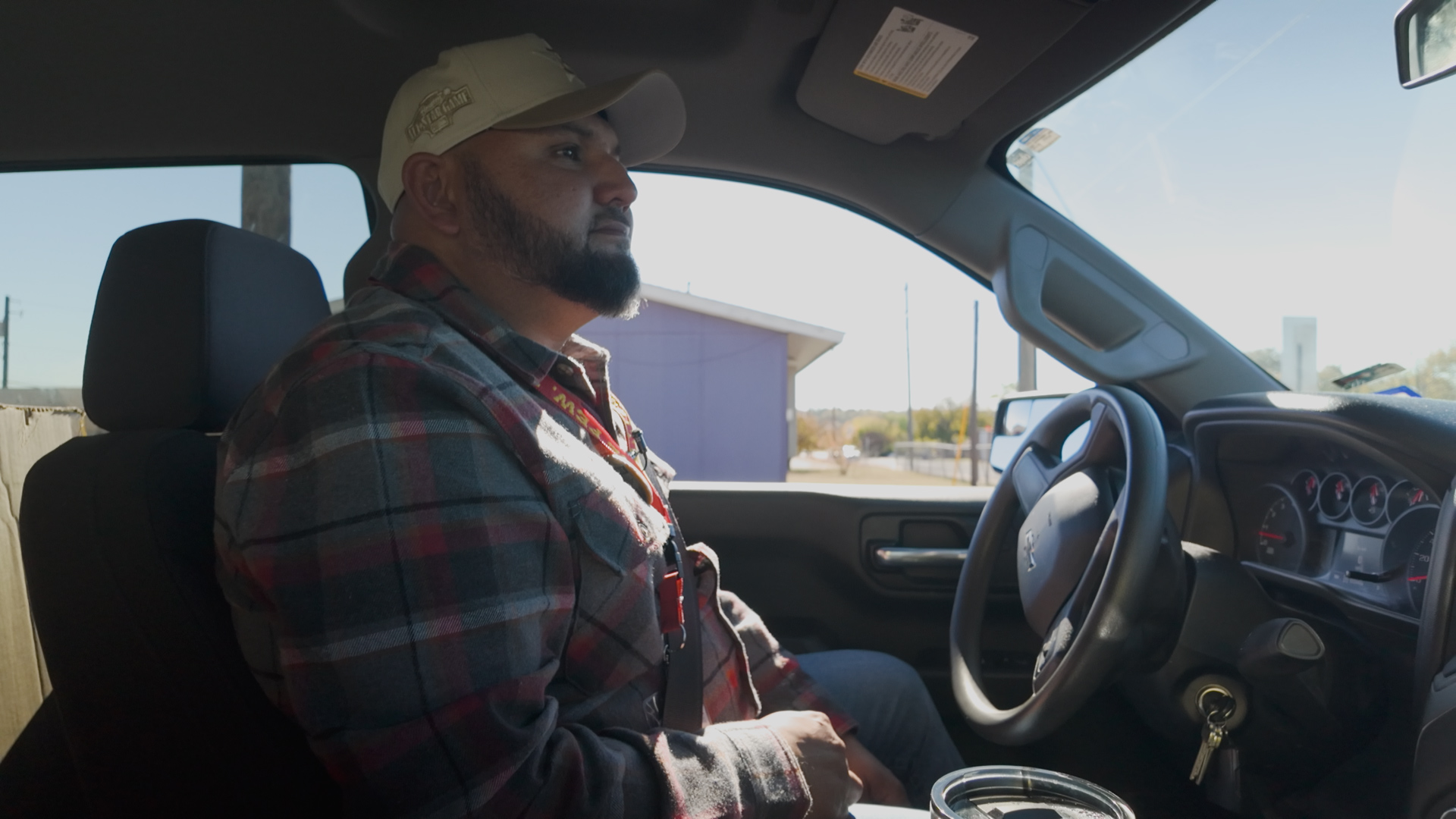Into The Melting Pot
Jose Carrasco doesn’t necessarily consider himself an expert on the Rundberg community, but he’s happy to share what he knows. Which just so happens to be quite a bit. Driving on Rundberg just east of Interstate 35, he points out a building to the north.
“Dobie Middle School … is right here in the heart of Rundberg. Dobie has been here 50 years,” he says. “The kids are amazing. It’s a really cool school to work at.”
Carrasco works with Austin Voices for Education and Youth and has served as the director of the Dobie Family Resource Center since 2015. In that time he’s come to know the community well. He also knows the reputation that the area has, one of violence and crime. But he feels that it’s a reputation that doesn’t get into the knotty challenges of the community, nor does it recognize the efforts by residents to improve the area.
“Rundberg is one big melting pot,” Carrasco says. “Unfortunately, Rundberg gets a bad rap.”
Jose Carrasco drives through the Rundberg community.
Located in North Austin, the Rundberg neighborhood is generally delineated by Cameron Road to the east and Metric Boulevard to the west, and Anderson Road to the south and Braker Lane up north. It’s made up of many smaller communities like Brownie, Georgian Acres and Stonegate. Key intersections along Cameron, I-35, and Lamar serve as central hubs within this bustling area, with businesses that speak to the diversity of the neighborhood: Afghan grocery stores, Honduran food trailers, and bahn mi restaurants. That diversity is reflected in the U.S. Census data. It shows that roughly 47% of residents speak a language other than English.
It’s a diversity that Carrasco sees reflected in the students at Dobie.
“At one time I think we had 15 different languages spoken at the school,” he says. “You can do a map of the world and probably find somebody here in Rundberg.”
Carrasco says part of the appeal for new arrivals is the cost. Housing costs in Rundberg are significantly lower than other parts of Austin. According to Zillow, the median home sale price for Rundberg homes last year was $391,207. That’s roughly $160,000 less than the going price for all of in Austin for 2024. Rent in Rundberg is closer to Austin overall–$1428 compared to $1528–but the amount can vary wildly depending on where residents go. Sometimes that lower price comes at a cost, like in the Brownie neighborhood.
“Brownie is the kind of place where they’ll rent to anyone, no questions asked,” Carrasco says. “But with the understanding that if something goes wrong, you can’t complain.”
Improving the area comes with challenges as well, Carrasco says.
“what happens if I start telling the city to come out here, doing code enforcement or a beautification project? Will the rent go up?” Carrasco says. “So how do I help without impacting someone’s ability to afford where they can live?”
It’s a hard balance to strike. The average income for the area is roughly $60,000, and over 17% of residents live below the federal poverty line. Many residents work downtown or in the Mueller area according to Carrasco, so moving to more affordable parts of central Texas can mean higher fuel costs.
“The city has housing programs and there’s other rental programs,” Carrasco says. “but sometimes there's just no assistance out there."
Despite the culture and community, Rundberg is often tied to crime. Austin Police Department data shows that while crime has been dropping in the area over the past four years, it still makes up a large percentage of Austin’s crime statistics. There were 16 homicides in Austin City Council District Four in 2024, according to APD data. That equals 24% of the city’s overall homicide cases. The neighborhood also makes up 22% of last year’s aggravated assault charges.
“The problem is we have the highway right here,” Carrasco says. “So people come in, they do whatever they’re going to do, then they leave.”
Numbers back Carrasco’s hunch. Research has indicated that interstates may increase crime in a county by as much as 8% in some instances.
Rundberg did see a dip in crime thanks in part to the Restore Rundberg Initiative. Kickstarted by an Obama-era Department Of Justice grant, the program fostered a partnership between Austin Police Department and community leaders. APD staffed extra officers in the area who focused on community policing. Metrics were measured by number of contacts made rather than arrests. Community organizations like READ were created. Between 2014 and 2015, violent crime went down 4.5%.
“But then the funding ran out,” Carrasco says. “And now those numbers have gone back up.”
Complicating the relationship between residents and law enforcement is the current national conversation on immigration. President Trump has begun rolling back immigration programs like the CPB One app and is sending troops to assist with border security efforts. In early January, the Houston DEA Office confirmed it had coordinated with ICE on arrests in the Austin area, though ICE has yet to confirm this. And while APD Chief Lisa Davis said in a statement she was not made aware of the arrests and they did not assist with them, the people targeted by federal officials had outstanding warrants and ‘were people we would be looking for anyway.’ Carrasco fears all this will further strain community policing efforts.
“You need people to feel okay calling the police in a place like this,” Carrasco says. “But I think this is going to get us further away from that.”
Carrasco finds hope in the area students he works with, and their families.
“They are super smart and super intelligent,” Carrasco says. “We have the best and brightest ... if we can just give them a little help, think of what they could do.”
The future of the area remains to be seen, but Carrasco encourages people to witness Rundberg as it is: a complicated place, but one also full of resiliency and community.
“America is one big melting pot, and that’s what Rundberg is,” Carrasco says. “America is Rundberg in every sense of the word.”
Community journalism doesn’t happen without community support.
Got story ideas, advice on how we can improve our reporting or just want to know more about what we do? Reach out to us at news@klru.org.
And if you value this type of reporting, then please consider making a donation to Austin PBS. Your gift makes the quality journalism done by the Decibel team possible. Thank you for your contribution.
More in Politics:
See all Politics posts






Contact Us
Email us at news@klru.org